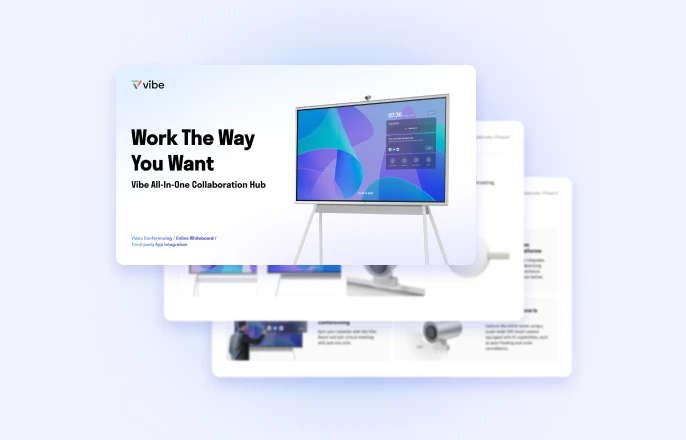The language in hospital dramas can be utterly confusing. (Unless you work in medicine, of course.) With all of that shorthand language flying across those fictional operating rooms, it’s hard to tell what’s being said or what any of it means. But with enough repetition, you become familiar with the jargon and can confidently follow the story.
Like many industries, working from home also comes with its own set of commonly used terms. You’re pretty sure there’s a difference between "screen sharing" and "screencasting"—but what is it? And are "working remotely" and "telecommuting" the same thing?
Use this guide as a reference for some of the common lingo you’ll encounter in WFH (that’s "work from home") scenarios.
Remote work
Remote work is a flexible working arrangement that allows an employee to work outside of a traditional office environment. Frequently, that involves creating a workspace at home, however, working remotely can be done anywhere someone has internet access.
Remote work arrangements are becoming increasingly common and can be temporary or permanent, part-time or full-time. In addition, more workplaces are looking beyond their communities to hire skilled remote workers to fill important roles in their companies. To learn more about many exciting remote working opportunities you may want to visit Jooble.org.
Agile
"A project management methodology characterized by building products that customers really want, using short cycles of work that allow for rapid production and constant revision if necessary." (Wrike)
Agile is a sprawling methodology with a language seemingly all its own. Luckily, the core concept is simple enough: individuals are important, customer collaboration is valued, and flexibility is key. Some companies pick-and-choose parts of the Agile methodology to adopt with their teams. One of those components is the stand-up meeting, which we’ll cover later.
Asynchronous
Communication that doesn’t happen in real time, either due to time zone differences among co-workers or an individual worker’s schedule.
You’re communicating asynchronously any time you send some type of work communication without expecting an immediate response. (Think Slack messages, emails, things like that.)
Fully remote and/or hybrid teams will almost always work asynchronously at some point during the work day. And depending on how far everyone is distributed (around the state? Country? World?), asynchronous work could be how everything gets done for your business.
Related: What to Know About Synchronous Communication and Asynchronous Communication
 Coworking spaces are an effective tool for remote teams
Coworking spaces are an effective tool for remote teamsCoworking
"[W]hen people assemble in a neutral space to work independently on different projects, or in groups on the same projects."
(DropDesk)
During the pandemic, many people are working outside of a group setting, so there hasn't been as much coworking lately. Still, when coworking spaces are a safe and healthy option, having a different place to work outside of the home or traditional office adds some variety (or peace and quiet) to your work day.
Digital nomad
A person who is able to fulfill his or her employment responsibilities while changing locations on a regular or irregular basis.
More simply: a remote worker who travels. The ability to move around and journey to new locations is often touted as one of the benefits of remote work, and it can be an adventurous lifestyle choice for the right person. Things to consider, though: consistently finding reliable wi-fi.
Distributed team
A group of employees working at different remote locations—not at a central headquarters—for the same company.
Many people who used to work at traditional offices are suddenly working as part of a newly distributed team. This change has given people time to think about what the future of work looks like for their companies. While some distributed teams will hang on, we’ll likely see more hybrid teams staying around for longer. (More on hybrid teams in a minute.)
Ergonomic
Items specially and specifically designed to make work more comfortable and/or efficient.
 Equip your home office with ergonomic tools, from standing desks and interactive whiteboards to comfortable desk chairs and keyboards.
Equip your home office with ergonomic tools, from standing desks and interactive whiteboards to comfortable desk chairs and keyboards.Maybe "ergonomic" doesn’t come up in conversation as often as the other terms here. But if you’re working from home, you should get familiar with this word quickly. Standing desks, tabletop desks, mouse pads, keyboards, foot stools, desk chairs—all of these work-from-home essentials come in a variety of designs to make your workspace comfortable.
Hybrid team
"[A] flexible work structure where some employees work remotely and other team members work from a central location or office." (Owl Labs)
Not every company has said goodbye to the office forever. But with so many teams working remotely and finding solutions to distanced collaboration, the option to work from home at least some of the time is more logical than ever. (Not to mention more appealing, too.) Digital whiteboards and software like Vibe make it easy to connect office and remote workers wherever they may be.
Retreat
An in-person get-together among remote workers from the same company.
You can have as many video conferences as you like, but it’s still a good idea to get your team together on occasion (once it’s considered safe and responsible to do so). A retreat is a great opportunity for the team to hang out in person and get to know each other on a personal level that would normally be achieved from daily in-office interactions.
Screencast / screen mirror / screen share
These three terms are often treated as synonyms in casual conversation; however, there are subtle yet distinct differences to help distinguish them. EdTech Magazine offers a good explanation:
Screen mirroring allows you to project your mobile device or laptop onto a TV screen, projector or other type of monitor. Exactly what is shown on the original screen will be shown on the other device.
Screencasting is similar to mirroring but is used to share online or streaming content like videos or movies.
Screen sharing usually involves providing another user with access to your screen on their screen.
Of these, screen sharing comes up most often in a remote work situation, since both screen mirroring and screencasting require users to be in the same room.
Vibe Boards enable both HDMI-connected or wireless screen mirroring and screen casting. People collaborating on a project can do work together using Vibe’s whiteboarding app, Canvas, and since Vibe projects are stored securely in the cloud there’s no need to provide access to another person’s workspace via screen sharing.
Related: How do I screencast with Vibe?
Stand-up meeting
A component of Agile work methodology that requires co-workers to stand while reviewing tasks for the day in a short meeting.
"I’ll have a quick progress update for you at tomorrow’s stand-up."
Sometimes shortened to simply "standup," this technique can be done both remotely or in-person. The gist of it is that if you’re standing, you’ll want to keep the meeting short…and that’s entirely the point.
Related: The Complete Guide to Conducting Remote Stand-up Meetings

Telecommute
"[T]o work from a remote location, usually a home office, by electronically linking to a company."
(The Balance Careers)
Think of telecommuting as a subset of remote work. Telecommuting is traditionally viewed as being completed off-site, though according to remote work site Virtual Vocations, the telecommuter would live closer to the company’s office than a digital nomad would.
Zoom fatigue
The general feeling of overwhelm that comes from being on too many Zoom calls in a short period of time.
It is totally possible to be worn out from countless video conferencing calls. So many of us are meeting online for work, to talk to family, to socialize with friends, and this is the substitute we have for in-person get togethers. Is it perfect? No. Is it acceptable to feel overwhelmed? Absolutely.
Vibe offers a collaborative solution combining an interactive digital whiteboard and innovative smart software. Increase engagement and efficiency at your brainstorming sessions, virtual training, and classroom sessions by integrating your favorite applications with video conferencing and an infinite, mess-free writing canvas. Collaborate today with Vibe.
Looking for the latest in interactive whiteboard technology? Check out Vibe today!








-1sbltxxq4FYxHrXrwJVLsCDNsXpqNa.webp)
-5Zp0pmSytvcuYDVs1LvuwplKuRneK0.webp)
